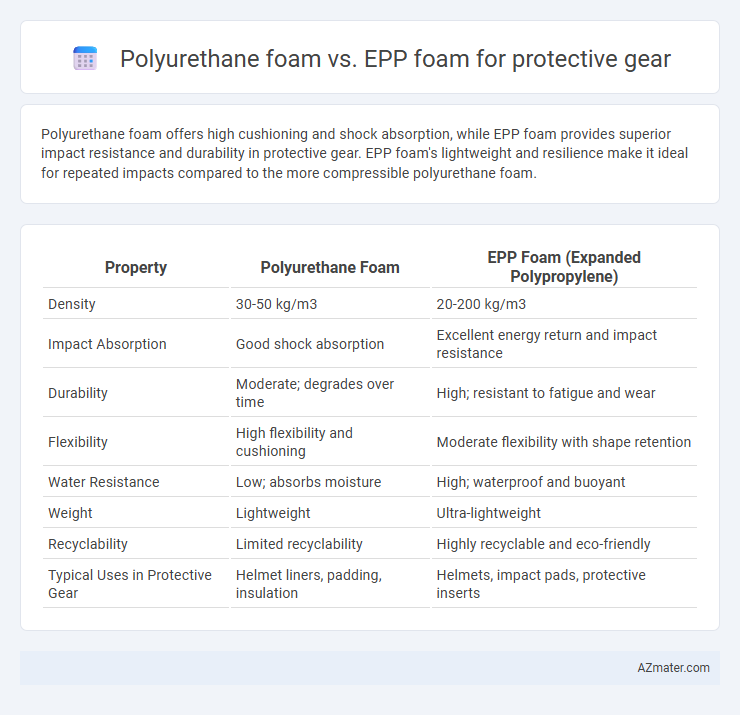Polyurethane foam offers high cushioning and shock absorption, while EPP foam provides superior impact resistance and durability in protective gear. EPP foam's lightweight and resilience make it ideal for repeated impacts compared to the more compressible polyurethane foam.
Table of Comparison
| Property | Polyurethane Foam | EPP Foam (Expanded Polypropylene) |
|---|---|---|
| Density | 30-50 kg/m3 | 20-200 kg/m3 |
| Impact Absorption | Good shock absorption | Excellent energy return and impact resistance |
| Durability | Moderate; degrades over time | High; resistant to fatigue and wear |
| Flexibility | High flexibility and cushioning | Moderate flexibility with shape retention |
| Water Resistance | Low; absorbs moisture | High; waterproof and buoyant |
| Weight | Lightweight | Ultra-lightweight |
| Recyclability | Limited recyclability | Highly recyclable and eco-friendly |
| Typical Uses in Protective Gear | Helmet liners, padding, insulation | Helmets, impact pads, protective inserts |
Introduction to Protective Gear Foams
Protective gear foams such as polyurethane (PU) foam and expanded polypropylene (EPP) foam serve critical roles in impact absorption and energy dispersion in safety equipment. Polyurethane foam is renowned for its cushioning properties, flexibility, and cost-effectiveness, making it ideal for applications requiring comfort and shock absorption. EPP foam offers superior resilience, lightweight durability, and excellent energy return, making it preferable in high-performance protective gear like helmets and body armor.
What is Polyurethane Foam?
Polyurethane foam is a versatile cushioning material widely used in protective gear for its excellent shock absorption and flexibility. It consists of polymer chains formed by reacting polyols with diisocyanates, creating a lightweight yet durable structure that effectively dissipates impact energy. This foam's ability to conform to various shapes while maintaining resilience makes it ideal for helmets, pads, and other protective equipment.
What is Expanded Polypropylene (EPP) Foam?
Expanded Polypropylene (EPP) foam is a lightweight, highly durable material known for its exceptional energy absorption and impact resistance, making it ideal for protective gear applications. Unlike polyurethane foam, EPP foam offers superior resilience, maintaining its cushioning properties after repeated impacts and providing enhanced protection in helmets, padding, and safety equipment. EPP's closed-cell structure also ensures better resistance to moisture, chemicals, and temperature variations, contributing to its widespread use in high-performance protective gear.
Material Structure and Composition
Polyurethane foam consists of a polymer matrix formed by reacting polyols and diisocyanates, resulting in a cellular structure with closed and open cells offering excellent shock absorption and flexibility. Expanded polypropylene (EPP) foam features a bead-blown bead-cell structure made from lightweight, semi-rigid polypropylene beads, providing superior energy return, impact resistance, and durability under repeated compression. The material composition of polyurethane foam emphasizes cushioning with softer, more flexible properties, whereas EPP foam prioritizes resilience and structural integrity, making each suitable for different protective gear applications based on required performance criteria.
Impact Absorption Capabilities
Polyurethane foam offers excellent initial impact absorption due to its open-cell structure that compresses under force, making it suitable for low to moderate impact protection. Expanded Polypropylene (EPP) foam provides superior energy dispersion and resilience, maintaining its shape after multiple impacts, which enhances long-term protective performance. EPP's closed-cell architecture delivers higher durability and better shock absorption, making it ideal for high-impact protective gear in sports and safety equipment.
Durability and Longevity
Polyurethane foam offers excellent shock absorption but tends to degrade faster with exposure to heat, moisture, and repeated impact, limiting its durability in protective gear. Expanded Polypropylene (EPP) foam provides superior longevity due to its resistance to deformation, moisture, and impact, maintaining cushioning properties over extended use. EPP foam's resilience and ability to recover shape after heavy impacts make it a preferred choice for high-performance protective equipment requiring long-lasting durability.
Weight and Flexibility Comparison
Polyurethane foam offers higher flexibility and cushioning, making it ideal for protective gear requiring impact absorption and comfort. Expanded polypropylene (EPP) foam is significantly lighter, providing excellent rigidity and shock resistance while maintaining a low weight profile. EPP's superior weight-to-strength ratio makes it favored for applications where lightweight protective equipment is crucial.
Comfort and Fit Considerations
Polyurethane foam offers superior cushioning and conforms closely to body contours, enhancing comfort in protective gear. EPP foam, while less conforming, provides excellent resilience and impact absorption with a lighter weight, contributing to a secure yet flexible fit. The choice between polyurethane and EPP foam depends on balancing plush comfort with durable support for optimal protective performance.
Cost and Environmental Impact
Polyurethane foam typically offers lower upfront costs compared to EPP foam, making it a common choice for budget-sensitive protective gear applications. EPP foam, while more expensive, excels in durability and recyclability, significantly reducing long-term environmental impact through extended product life and ease of reuse. Cost efficiency in polyurethane contrasts with the sustainable benefits of EPP, especially in industries prioritizing eco-friendly materials and waste reduction.
Best Applications: Polyurethane vs EPP in Protective Gear
Polyurethane foam offers excellent impact absorption and cushioning, making it ideal for helmets, knee pads, and gloves that require high shock protection and comfort. Expanded Polypropylene (EPP) foam provides superior durability, lightweight resilience, and repeated impact resistance, which suits protective gear in automotive, sports, and military applications where long-term performance under stress is critical. Selecting between polyurethane and EPP foam depends on balancing factors like energy absorption, weight, and longevity based on the specific protective gear requirements.

Infographic: Polyurethane foam vs EPP foam for Protective gear
 azmater.com
azmater.com